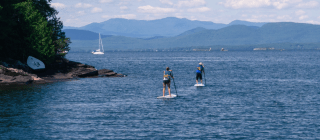Spending Time in Blue Spaces Improves Your Health

Outdoor spaces that include water are called "blue spaces." Learn how they can help improve your mental and physical wellbeing.
Vermont has more than 800 lakes and ponds and about 7,000 miles of rivers. The abundance of waterways in our state not only provides many opportunities for recreation, it also helps us improve our physical and mental health.
Lakes, ponds, rivers, and other outdoor spaces that include water are called “blue spaces.” The term takes its name from the hue of water. Researchers have found that when people spend time in blue spaces, they are happier and have a greater sense of well-being. People also tend to get more exercise when they are in blue spaces.
Let’s take a closer look at the health benefits of blue spaces and discuss how you can incorporate blue spaces into your life.
Health Benefits of Blue Spaces
Visiting a lake, pond, or river swimming hole on a summer day, you’ll likely find plenty of Vermonters enjoying activities like swimming and kayaking. How does spending time on or near the water help improve our health? These blue spaces are beneficial to health because they:
- Promote calmness. The tranquility of the water tends to have a calming effect on the mind.
- Reduce stress. Studies have shown that time in blue spaces can lead to feelings of happiness and reduced anxiety.
- Stimulate healing. The buoyancy of water helps increase range of motion, allowing people to exercise with less pain while floating. The hydrostatic pressure of water increases blood circulation, which helps boost delivery of oxygen and nutrients to tissues and promote healing.
- Encourage physical activity. Water sports like swimming, canoeing, kayaking, and paddleboarding are great aerobic exercise, elevating the heart rate and using different muscle groups.
- Promote sleep. The gentle sounds of water are soothing and help us to drift off to sleep. Reduced stress and anxiety from time spent in blue spaces also helps us sleep better.
- Increase social connection. People often gather with friends and family in blue spaces, which encourages social interaction and builds a sense of community.
How to Visit Blue Spaces
You don’t need to spend a lot of money to reap the health benefits of blue spaces. In Vermont, many blue spaces are publicly accessible for free or by paying a small fee, such as admission to Vermont State Parks.
While individuals or organizations can own the land around a lake or other navigable body of water, the water and the land beneath it is owned by the public. The Vermont Department of Environmental Conservation manages public waters, including making use of public waters rules to ensure everyone can enjoy time on the water.
Vermont has an extensive network of public access points to blue spaces, including:
- Fishing access areas. The Vermont Fish & Wildlife Department maintains more than 200 fishing access areas, all open to the public for free.
- State parks. More than 30 Vermont State Parks offer swimming. Most parks located on bodies of water have beaches and offer canoe and kayak rentals.
- Community beaches. In addition to beaches at state parks, many Vermont communities located on bodies of water maintain beaches for residents and visitors. Check out this guide to Vermont beaches.
- Swimming holes. Just about every river and stream in Vermont has a swimming hole that is heavily used on a hot summer day. Some are informal and others are official sites. The Vermont River Conservancy has a map of 26 conserved swimming holes that are open to the public. Please be aware that swimming holes can be dangerous and drownings have happened. Obey all signs posted at swimming holes and follow these water safety tips from the Vermont Department of Health.
What to Do in Blue Spaces
Once you get to a blue space, how can you enjoy the water? Here are some suggestions for recreational activities and places where you can learn more about them and access equipment.
- Paddleboarding is one of the fastest-growing water sports. People enjoy the low-impact total body workout that paddleboarding offers. Watch this introductory video from our wellness team to learn how to start paddleboarding.
- Kayaking provides an excellent upper body workout, using the arms, back, and shoulders. As you twist your torso to pull each end of the paddle through the water, kayaking also helps strengthen your core muscles. Several Vermont outdoor outfitting shops offer rentals, tours, and instructional classes. A great place for first-timers to check out kayaking is Umiak’s location at the Waterbury Reservoir.
- Canoeing is usually less intense than kayaking, but still offers a good cardiovascular workout that is gentle on your joints. Canoeing helps build muscle strength and improves flexibility. Several Vermont outfitters offer canoeing lessons and guided tours. The Vermont Paddlers Club website has many resources, including trips and instructional clinics.
- Sculling uses a narrow boat that glides through the water, propelled by two lengthy oars. Sculling requires good balance and the precise rowing technique can be challenging to learn. The Craftsbury Outdoor Center offers sculling camps and afternoon community rowing sessions on Great Hosmer Pond.
- Sailing may not seem like it offers much exercise, but the work of hoisting and lowering the sails can build muscle strength and improve balance. Sailing also requires constant attention and quick decision making, which helps improve cognitive function. The Community Sailing Center in Burlington offers programs for kids and adults, along with boat rentals on Lake Champlain.
- Fishing is a relaxing sport that lowers stress hormone levels and reduces anxiety. Casting helps build eye-hand coordination, and the fish you catch can be the foundation of a healthy meal. The Vermont Fish & Wildlife Department offers a Let’s Go Fishing Program, where volunteers around the state teach kids and adults how to fish.
- Swimming is one of the best ways to burn calories, with moderate swimming consuming between 400 and 500 calories per hour. Overcoming the resistance of water forces your muscles to work harder, helping build strength and stamina. Many fitness centers in Vermont offer swimming lessons, as does the Greater Burlington YMCA.
- Scuba diving and snorkeling allow you to explore what’s under the water, while getting a cardiovascular workout similar to swimming. The visual aspect of scuba diving improves your mood, and the slow breathing technique divers use lowers blood pressure. The Waterfront Diving Center in Burlington offers training, rentals, and local charters.
Blue Space Therapy
Spending time in and around bodies of water has so many positive impacts on physical and mental health that some people call it “blue space therapy.” The next time you want to reduce stress, boost your mood, and get in a good workout, we hope you’ll get some blue space therapy by visiting one of Vermont’s many lakes, ponds, and rivers.



